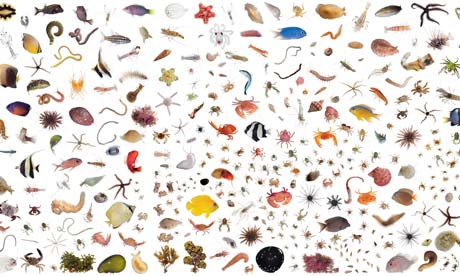Just how much life can you find in an ecosystem of one cubic foot? That is the question photographer David Liittschwager set out to answer when he took a 12-inch metal frame to a range of different environments on land and in water, in tropical climes and temperate regions and began to chart the living organisms.
The answer? An astonishing amount. In each place he visited, the photographer, best known for his large images of rare animals and plants, was amazed at the diversity and abundance of life that passed through such a small area.
In five distinct and contrasting environments, from a tropical forest to a city-centre park, Liittschwager set down his green-edged metal cube, and started watching. Each creature that passed through the cube was counted and charted with the help of his assistant and a team of biologists. Over a three-week period the team photographed each inhabitant that passed through the cube, down to creatures measuring a mere millimetre.
In total, more than a thousand individual organisms were photographed, and the diversity of each environment can be seen on nationalgeographic.com. "It was like finding little gems," Liittschwager said.
The team started out at Central Park in New York – or more specifically, in the Hallet nature sanctuary, a 3.5-acre deciduous woodland area, populated with trees or shrubs that lose their leaves seasonally. There they found the tufted titmouse and eastern grey squirrel, creatures as big as a raccoon and as small as a leopard slug.
In Moorea, in French Polynesia, they discovered a vast array of species (pictured) thought to only be a very small selection of the reef's full diversity. Among their findings were the inch-long file clam, the whitespotted boxfish, sacoglossan sea slug and the frankly terrifying post-larval octopus.
While in the tropical cloud forest of Monteverde, in Costa Rica, most of the animals in the treetop ecosystem were as small as a fingertip, there were hawk moths, sharpshooter leafhoppers and burio tree seeds.
The fine-leaved vegetation of the fynbos of Table Mountain in South Africa, thought to hold one of the richest concentrations of plant diversity in the world, revealed the purple flower of the alice sundew, and no shortage of cape zebra cockroaches. Finally, in the fresh water of Duck River in Tennessee, one of the most biodiverse waterways in the US, swam golden darters and longlear sunfish as well as the bigeyed chub.










